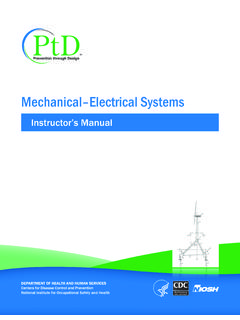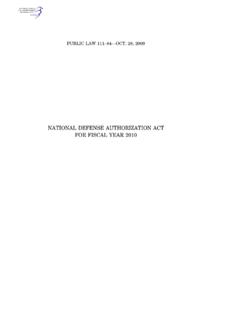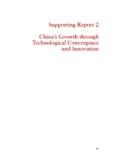Transcription of POLAND - OECD.org
1 SCIENCE AND INNOVATION: POLANDOECD SCIENCE, TECHNOLOGY AND INDUSTRY OUTLOOK 2012 OECD 2012360 POLANDG eneral features of the STI system: The Polisheconomy outperformed other EU countries duringthe recent global financial crisis. In spite of Polishfirms improved competitiveness on export markets,the STI system is characterised by a business sectorwhich innovates relatively little and a weakacademic system. In 2010, BERD was of GDP,among the lowest in the OECD (Panel 1(d)). Linksbetween industry and science have traditionallybeen weak, a legacy of the state planned economy. Asmall proportion of public research is funded byindustry (1(o)) and very few patents are filed byuniversities and PRIs (1(p)). The integration of Polishscience in international networks is better inindustry (1(r)) than in academia (1(q)).
2 POLAND enjoysan RTA in emerging technologies such asbiotechnology and nanotechnology, but hasperformed less well in ICT technologies (Panel 3).Enhancing human capital would improveinnovation capacity: just 23% of the adult populationhas tertiary level education and only 27% of personsemployed are in S&T occupations (1(s)(v)). POLAND hasa very low researchers per 1 000 , PISA science scores of Polish 15-year-oldsare almost at the OECD median (1(t)). The ICTinfrastructure is well developed: POLAND has 14 fixedbroadband and 51 wireless subscribers per 100inhabitants (1(l)(m)). The e-government readinessindex, however, is comparatively low (1(n)).Recent changes in STI expenditures: In 2010, POLAND sGERD was of GDP. However, GERD grew by arobust a year between 2005 and 2010.
3 POLAND starget is for GERD to reach of GDP by 2010, industry funded a comparatively low 24% ofGERD, while government funded 61%. The share ofGERD financed from abroad doubled to 12%.Overall STI strategy: POLAND s STI strategy hasrecently been updated to include longer-termobjectives. The more forward-looking long-termstrategies, POLAND 2030: The Third Wave ofModernity and the Strategy for the Innovativenessand Effectiveness of the Economy (2012-20),complement the National Reform Programme(NRP) and the Innovative Economy objective of the National Cohesion Strategy(NCS) is to create favourable conditions forcompetitiveness. The new Science DevelopmentProgramme and Entrepreneurship DevelopmentProgramme promote a knowledge-based economybuilt on current strengths, emerging technologiesand smart specialisation.
4 The National ForesightProgramme, POLAND 2020, and the foresightprogramme InSight2030 outline potential scenariosfor the next two decades. Hot STI issues Implementing policies for a knowledge-based economy. Increasing R&D expenditure and improving the effectiveness of public research through better fundingand governance. Stimulating innovation in the business sector and entrepreneurship. Increasing the qualifications and effectiveness of research figuresLabour productivity, GDP per hour worked in USD, , as % of GDP, (annual growth rate, 2005-10 )(+ ) (annual growth rate, 2005-10)(+ )Environmental productivity, GDP per unit of CO2 emitted in USD, publicly financed, as % of GDP, (annual growth rate, 2005-09)(+ ) (annual growth rate, 2005-10)(+ ) SCIENCE AND INNOVATION: POLANDOECD SCIENCE, TECHNOLOGY AND INDUSTRY OUTLOOK 2012 OECD 2012361 Figure and innovation in PolandNote:Normalised index of performance relative to the median values in the OECD area (Index median = 100).
5 050100150200100020015050 Public R&D expenditure (per GDP) (a) Top 500 universities (per GDP) (b) Publications in the top-quartile journals (per GDP) (c)Fixed broadband suscribers (per population) (k) Wireless broadband suscribers (per population) (l) Networks (autonomous systems) (per population) (m) E-government readiness index (n) Industry-financed public R&D expenditures (per GDP) (o) Patents filed by universities and public labs (per GDP) (p) International co-authorship (%) (q) International co-patenting (%) (r) Adult population at tertiary education level (%) (s) 15-year-old top performers in science (%) (t) Doctoral graduation rate in science and engineering (u) S&T occupations in total employment (%) (v)Business R&D expenditure (per GDP) (d) Top 500 corporate R&D investors (per GDP) (e) Triadic patent families (per GDP) (f) Trademarks (per GDP) (g) Venture capital (per GDP) (h) Patenting firms less than 5 years old (per GDP) (i) Ease of entrepreneurship index (j)Top halfOECD Bottom halfOECD Science baseBusiness R&D and innovationEntrepreneurshipPanel 1.
6 Comparative performance of national science and innovation systems, 2011a. Competences and capacity to innovateTop/bottom 5 OECD valuesMiddle range of OECD valuesOECD medianPolandb. Interactions and human resources for innovationKnowledge flows andcommercialisation Internet for innovationHuman resourcesTop halfOECD Bottom halfOECD SCIENCE AND INNOVATION: POLANDOECD SCIENCE, TECHNOLOGY AND INDUSTRY OUTLOOK 2012 OECD 2012362 STI policy governance: Since 2010, changes to STIgovernance have been introduced to reducefragmentation and improve co-ordination. TheMinistry of Science and Higher Education (MSHE) isresponsible for S&T policy design and the Ministryof Economy is in charge of innovation policy. Theimplementation of S&T policy is outsourced to theNational R&D Centre (NCBiR), established in 2007,and the National Science Centre (NSC), createdin 2010.
7 The former was reformed in 2010 toimprove public-private co-operation and increaseprivate R&D spending. The Polish Agency forEntrepreneurship Development (PARP), supervisedby the Ministry of Economy, is co-responsible forimplementing innovation policy. Science base: Despite a strong tradition in basicscience, POLAND s public-sector R&D spending as ashare of GDP is low and rankings of universities andinternational publications are below the OECD median (1(a)(b)(c)). Part of the problem stems fromfragmented sources of research funding, lack ofcompetition and weak incentives for researchexcellence. Recently the science budget wasincreased by 29% and six new acts were passed todevelop a more effective research system. At thesame time, the government aims to increase theshare of competitive-based research fundingrelative to block or statutory R&D and innovation: Polish firms arecompetitive on international markets astheir strong export performance shows.
8 However,they compete mainly on price, and few firms,particularly among SMEs, invest in R&D andinnovation activities. This results in low ratios ofBERD and patents to GDP (1(d)(f)). Entrepreneurship: The government introduced one-stop shops to make business start-ups cheaper andfaster. Although small, the Polish venture capitalmarket is the biggest in eastern Europe. The NationalCapital Fund was launched in 2007 to boost part of the Technological Initiative programme,the Bank Gospodarstwa Krajowego (BGK) issuestechnology credits to micro firms and and scientific infrastructures: The Research andDevelopment of New Technologies Programme hasreceived USD 359 million in funding for ICTinfrastructure development. The Polish Roadmapfor Research Infrastructure is being funded upto USD billion.
9 Finally, the NRP flagshipinitiative, Innovation Union, has been allocatedUSD 484 million to upgrade obsolete researchinfrastructures. Clusters and regional policies: Cluster developmentis gaining increasing support. The Strategy forIncreasing the Innovativeness of the Economy2007-13 incorporates measures to support anddevelop clusters in national and regionaloperational programmes (OPs). Regional OPsoperate in all 16 provinces (voivodships). Knowledge flows and commercialisation: To facilitateknowledge flows and commercialisation, the MSHE launched a Guide for the Commercialisation of R&Dfor practitioners and the Patent Office assistsuniversities. The IniTech project, Applied ResearchProgrammes and Innovation Creator, financiallysupports knowledge transfer between researchersand entrepreneurs.
10 The Innovation Voucherprogramme targets collaboration between SMEs andresearch institutions. The NCBiR also strengthensco-operation between business and technologicalplatforms through public-private partnership. Human resources: Human capital development is anational priority, with investment from the HumanCapital Operational Programme and the 2011, almost USD billion was budgeted forhigher education and science, and the NationalQualifications Framework and National LeadershipCentres (KNOW) were introduced. Mobility Plus is acompetitive incentive programme for academicresearchers. The Top 500 Innovators Programmefunds researcher exchanges with top-ranking worldresearch institutions. Emerging technologies: In 2011, the NCBiRintroduced strategic research programmes forkey technological areas for socioeconomicdevelopment.














